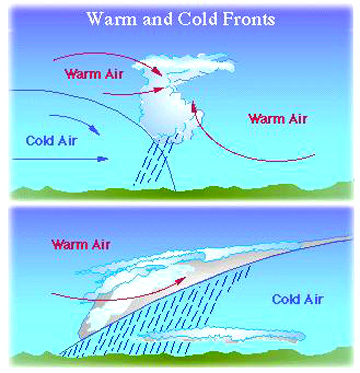|
Let's
first start with some definitions that will help you understand
precipitation and rain.
Evaporation
- is when a liquid becomes a gas. For example, a water left in
a bowl will slowly disappear. The water evaporates into water
vapor, the gas phase of water. The water vapor mixes with the
air.
Condensation-Condensation
is the process in which water vapor changes into a water droplet
or ice crystal. It is the opposite of evaporation.
Transpiration
- Transpiration is a process similar to evaporation. It is a part
of the water cycle, and it is the loss of water vapor from parts
of plants (similar to sweating)
Weather
Fronts - A weather front is a boundary separating two masses
of air of different densities.
 |
Cold
Front -- A cold front is defined as the leading edge of a
cooler mass of air, replacing (at ground level) a warmer mass
of air. |
 |
Warm
Front -- A warm front is defined as the transition zone where
a warm air mass is replacing a cold air mass. |
 |
Stationary
Front -is a boundary between two different air masses, neither
of which is strong enough to replace the other. |
Precipitation
-any product of the condensation of atmospheric water vapor that
falls under gravity. The main forms of precipitation include drizzle,
rain, sleet, snow, and hail.
Dew Point
- The
dew point is the temperature where water vapor condenses into
liquid water. Condensation of water vapor starts when the temperature
of air is lowered to its dew point and beyond.
The Water
cycle - The water cycle is the cycle water goes through on
Earth. See the image below for a clear description of the water
cycle.
|
 |
|
The
water cycle, also known as the hydrologic cycle, refers
to the continuous movement of water between the earth
and the atmosphere. The main components of the water
cycle are:
1. Evaporation and Transpiration
2. Condensation
3. Precipitation
4. Runoff and Groundwater
Image
and further discussion at: http://www.noaa.gov/
|
What
causes precipitation as rain or snow?
1- Water
from evaporation and transpiration rises (see schematic
above)
2- As warm air rises it cools and causes condensation of
water vapor into tiny droplets.
|
NOTE:
Warm air can hold more water vapor than cold air.
Clouds
will form when air becomes supersaturated, forcing
water vapor in the atmosphere to condense into visible
liquid cloud droplets.
|
3-
Water droplets increase in size until it can no longer be
supported by an upward movement of air. It then falls to
the ground.
 |
|
To
the left is a diagram showing two air masses in
proximity with their fronts designated Cold (top
panel) where the cold air mass is steep and Warm
where the front is more gentle. Note that the cold,
heavier air mass, associated with a High, is typically
below the lighter warm air.
Image:
Nasa_gsfc
|
What
causes dew on the ground?
Dew
is a thin film of water that has condensed on the surface
of objects near the ground in the morning or evening.
These objects cool in the night. When they cool, the thin
layer of air around them cools too. This makes some water
vapor condense on the object. The condensation happens
because the air is able to hold less water when it is
cooled. The temperature when condensation begins is called
the dew point. If the dew point temperature becomes lower
than 32 °F (0 °C), the dew turns into frost.
|
|

